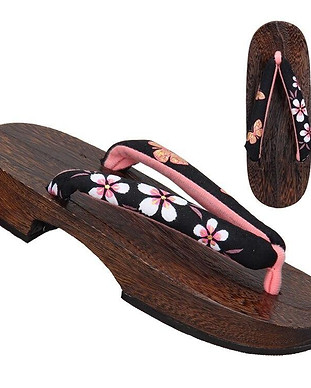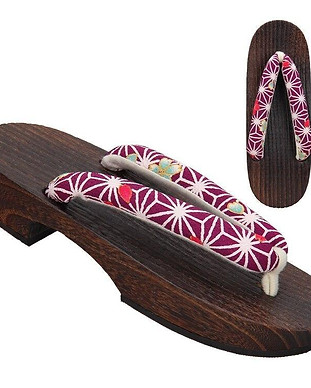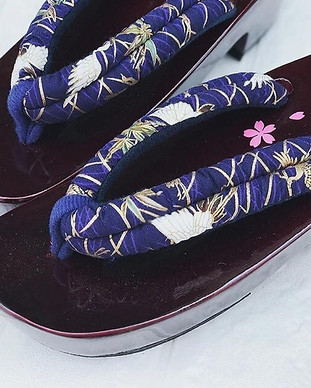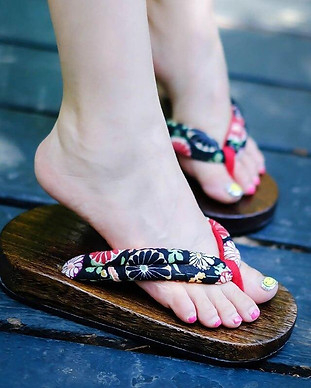Discover our geta collection, these Japanese sandals ideal to complete an official outfit or a Cosplay costume. Select a geta pattern and choose your pair from many Japanese patterns.
Japanese geta are wooden sandals, traditionally worn in Japan with a kimono or yukata. Often the sole is raised on two platforms, called "teeth". The foot is held in place with a fabric strap that goes between the toes.
The geta, the famous Japanese wooden sandals
With their wooden sole and fabric strap that pass between the toes, these traditional shoes from Japan are a bit like the ancestors of our current flip-flops. Usually worn with a kimono, geta are just as emblematic of the land of the rising sun. Practical and comfortable - although this may not be the first idea a Westerner might have of it - Japanese geta are primarily used to give height to prevent the kimono from dragging on the floor. Nowadays, they can be worn with traditional Japanese clothing, Western clothing and summer outfits, although their use is becoming increasingly rare. It is found especially during ceremonies, festivals or at the feet of geishas.
The different types of geta
There are many forms of geta in Japan - each pair of shoes is suitable for an occasion or social status - but these wooden sandals always consist of a body or sole (dai) and a fabric strap (hanao ). The difference between geta is usually in the platforms or teeth (ha) that raise the sole. These teeth can be present, absent, two in number, unique, high or short depending on the model. Often the underside of the tines have a rubber coating to prevent slipping, to reduce wear on the wood and to dampen the noise of clicking on the ground.
Hiyori geta: These are the most common geta, they have two teeth (about 5 cm) and make a clicking noise on the ground recognizable among a thousand. The teeth and the sole are cut from a single block of wood. These geta are worn by women as well as by men. The difference lies in the shape of the sole: more rounded for women and more square for men. For rainy days, the Japanese wear ama geta, a lacquered version fitted with a toe cover.
Bankara geta: Unlike hiyori geta, the teeth of bankara geta do not form a single block with the sole so that they can be changed once worn. The teeth are also higher. Bankara geta are generally worn by students.
Tengu geta: Easily recognizable, the tengu geta have only one tooth placed in the center of the sole. Getting around with this kind of sandals requires a lot of training and balance, they are generally reserved for theater actors and traditional dances.
Oiran geta: These Japanese sandals have three very high teeth (about 22 cm). In the Edo period, these geta were worn by the Oiran, high-ranking courtesans, hence their name.
Okobo: Also called "pokkuri geta" because of the particular noise of these sandals on the ground (the pokkuri sound being an onomatopoeia of this noise), the geta okobo are made of a single block of wood with a height of 10 cm. . The sole is hollow and may have a small bell. This kind of geta is reserved for women and more particularly for maiko, apprentice geisha.
Ukon geta: The ukon geta correspond to an evolved form of this sandal, an excellent compromise between the Japanese style and the comfort of the slippers. This pair of sandals has a flat or slightly raised sole with a wide heel at the back. If one were to compare this shoe with a Western equivalent, then they would be comfortable, light and stylish slides, perfect for the home.
How to wear Japanese geta?
These traditional Japanese sandals are worn barefoot or with Japanese fingered socks, the tabi. These sandals are known to be good for posture and against back pain. Usually, the Japanese choose the size of the geta so that their heels protrude slightly from the back. To fully enjoy the comfort of geta, you must ensure that your feet are perfectly supported by the fabric strap. If your feet come off the sole when you walk, you risk twisting an ankle. To avoid this, you can tighten the strap by pulling on the visible threads under the sole.
Our Japanese sandals have been carefully selected to guarantee you the best quality while offering you a wide choice of soles, colors and prints. To be sure to choose the size that suits you, check our size guide in each description.
By MEDHY_SAMA





























